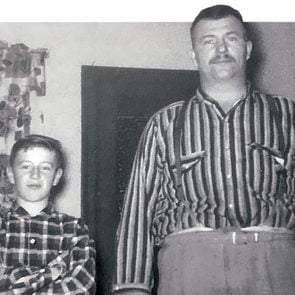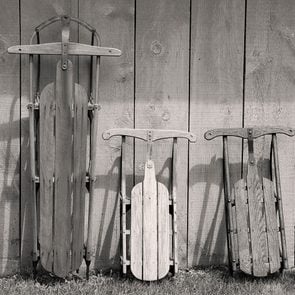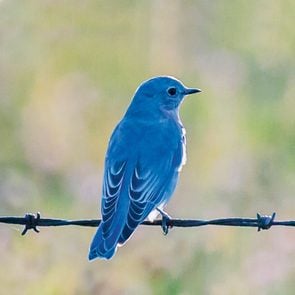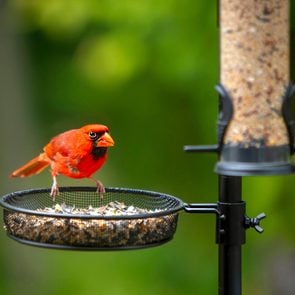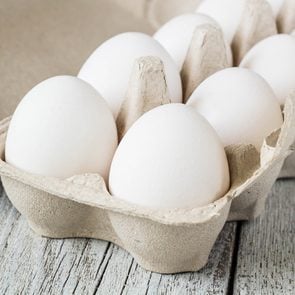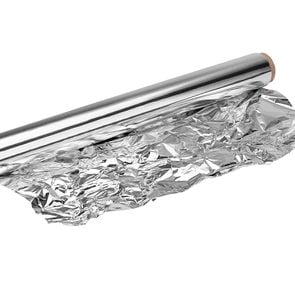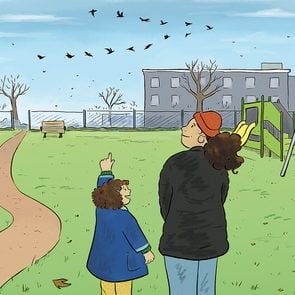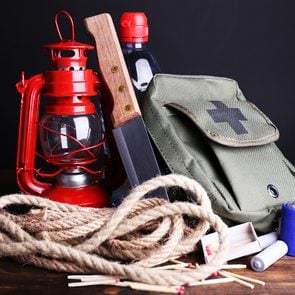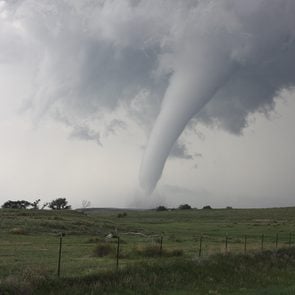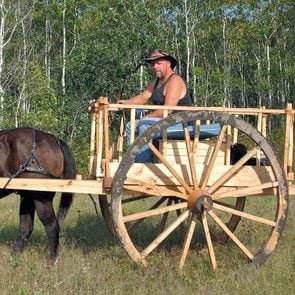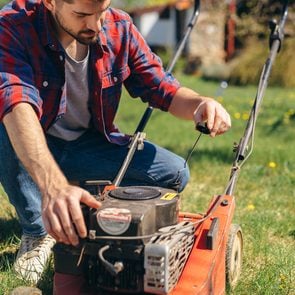Blue-light-blocking glasses are supposed to combat the effects of short-wavelength light emitting from our smartphones, computer screens and LED lights: namely, eye strain leading to poor sleep and possibly cataracts and macular degeneration. They can range from under $15 all the way up to several hundred dollars. But do blue light glasses work?
Dr. Elizabeth Esparaz, an ophthalmologist and lifestyle medicine specialist based in Cleveland, Ohio, says the science that manufacturers share to promote these glasses can be confusing. For starters, blue light isn’t just about tech devices, and it’s not always bad.
“The sun emits a much higher intensity of blue light than human-made devices, of course, and it’s actually beneficial,” says Dr. Esparaz. It helps our mood, alertness and sleep-wake cycle. However, blue light at night is not a good thing: It suppresses the release of melatonin. “Melatonin helps regulate our circadian rhythms and makes us sleepy,” says Dr. Esparaz.
So, in theory, blue-light-blocking glasses should help people who watch movies in bed or read from a tablet at night to avoid sleeplessness. Indeed, a 2021 review from the University of Oklahoma that looked at 24 previous studies found people affected by sleep disorders, jet lag and shift work fell asleep faster after using these glasses.
As for eye strain, an Australian study of 120 people in 2021 showed that those wearing the glasses did not experience less eye strain than those using clear glasses. And a 2018 review study, also by Australian researchers, concluded that there was insufficient evidence to show that they prevent macular degeneration.
“These glasses aren’t going to be harmful,” says Dr. Esparaz, so people who find them effective should keep using them. But, she adds, a lack of standardization in the industry means there’s no way to know if one pair is better than another.
You can always activate the blue-light-filtering function on your devices and limit screen time before bed. To help combat eye strain, Dr. Esparaz suggests taking breaks and using lubricating eye drops.
Now that you know how blue light glasses work, find out why you should always read before bed.
One of the last things I remember doing with my dad, before he got so sick, was building a soapbox racer in our hometown of Moose Jaw, Saskatchewan, in the summer of 1955. Back then, racers were built out of spare parts. Scrap lumber, old pieces of rope, rusty nails and axles and wheels. Ah yes, wheels. The Holy Grail of racer construction. During soapbox construction season, there was not a baby-carriage wheel, toy-wagon wheel or any other garden piece or home-use wheel that was safe. Many were the back porches that held baby carriages with only the two front wheels or an American Flyer red wagon without any wheels at all. Wheels were everything and the solid red ones with the rubber tires were the most valued.
Racers were built for speed and speed alone. No extraneous frills or doodads were allowed. The object was to be the fastest in the land. Steering mechanisms consisted of lengths of rope fastened to the moveable board at the front that held the axle and guide wheels or very often, nothing at all—the steering was accomplished by simply pushing on the board with your feet. Some even had steering wheels attached by some unexplainable method, but we didn’t associate with those kinds of people. Brakes were, at best, an afterthought and usually consisted of a stick that made contact with the ground. Sometimes, it was attached to the body but often was simply laid in the driver’s lap.
Races would be held on Saturday in order, it seemed, to cause as much chaos in city traffic patterns as possible. Every year, the chamber of commerce would protest to the city council and every year the councillors would ignore their request.
People would begin lining up along the race route hours before the start. They would bring lawn chairs and boxes of sandwiches, fruit and thermoses of coffee. The race route itself was only five or six blocks long, so prime viewing space was at a premium.
Racers would be lined up eight or ten across the top of the biggest hill in town, with a pusher behind each one. Upon the signal, the pusher would do just that to his appointed racer with each of them trying to out-do the next for starting speed. The racers would begin careening down the hill. The more poorly engineered and constructed ones would begin to fly apart almost instantly, with wheels, pieces of wood, axles and every other part flying around the track and drivers rolling invariably into the crowd who, while risking dire injury, seemed to enjoy the whole experience. Farther down the track, the collisions would begin as the frail steering systems failed. More flying parts. More rolling drivers. More pandemonium. It was great fun to watch!
After a great many heats, a final winner would appear. It was akin to being the winner of a demolition derby, in that the winner was not necessarily the fastest but simply the survivor.
Looking back on these events today, I don’t remember actually taking much of a part in the construction of the racer. That was probably more the work of my older brother. I also don’t remember driving the actual racer—that was probably my brother, too. In fact, the only thing I do remember vividly about soapbox racing in Moose Jaw was spending time with my dad.
Next, find out what it was like learning to drive on the farm in the ’60s.
There really is nothing common about the common loon. From its eerily haunting calls, iridescent plumage, brilliant scarlet-red eyes, legs set awkwardly far back and large webbed feet, to its pure natural beauty, it would have been more fittingly named the uncommon loon.
The common loon’s taxonomic name, Gavia immer, comes from gavia—Latin for “ancient seabird”—and immer—derived from the Latin immergo (to plunge) or directly from the Norwegian for “great northern diver.” Able to plunge to depths of 200 feet, remain submerged for several minutes and fly nonstop across hundreds of miles in a single flight, the common loon is truly a Superman in the aquatic-bird world.
Its English name, loon, comes from its awkwardness on land. With legs and large webbed feet back near the end of its body, underwater it’s a streamlined, extremely fast and agile bird torpedo. On land, however, due to the rearward position of its legs and feet, it looks like a bit of a drunken sailor.
Except when in flight, loons leave the water only to mate or incubate eggs in their nests. A loon found on land for any other reason is like a fish out of water and is probably sick or injured, or has somehow missed its watery runway and either needs help to return to the water or an immediate rescue.
The Eyes Have It
The loon’s brilliant red eyes aren’t that colour by accident or to enhance its dashing good looks; there’s a real science behind them. If you’ve ever gone snorkelling or scuba diving and own a GoPro camera, you’ll know that a red filter is a must-have underwater. Well, needless to say, the common loon had the science eons before GoPro.
Water absorbs light, and colour is simply different wavelengths or particles of light. Red light has the longest wavelength of visible colours, therefore it has the least amount of energy. This energy is absorbed underwater at a depth of 12-15 feet, so the colour disappears; a bit deeper, orange and then yellow follow. By the time the loon reaches a depth of 50-60 feet, all low-energy light and colour are gone. Everything would appear a muted bluish-green—as only these shorter wavelengths remain—if not for the loon’s red eyes, filtering these colours out. The red not only returns some natural colour to the underwater world at depth, but, more importantly, adds a greater distinguishable contrast between prey and its environment, allowing the loon to easily spot the fish, crustaceans and insect larvae that would have been otherwise perfectly colour-muted and camouflaged.

Together Forever (Sometimes)
Living for up to 30 years, it was once thought that loon couples mated for life. New research suggests that territory eclipses monogamy, however, and a mother bird having the ideal place to raise her chicks takes priority. Transient bachelor loons may launch challenges for territory; if successful, the resident male is driven off, with the intruder acquiring not only his territory but also his mate. However, a mated pair that can defend and retain their territory will remain together for many years, returning to Canada from their ocean vacations on the Gulf Coast or in Mexico each spring to nest and raise a family. Loons typically refurbish the previous year’s nest, and the female then lays one or two eggs. These take about four weeks to hatch, with chicks arriving sometime in late June or early July. Once hatched, these tiny brown fluffball chicks are able to swim immediately and never return to the nest, preferring instead to ride high or to tuck under the wing of either mom or dad, which offers both warmth and protection. The chicks, however, grow quickly and their hitchhiking ends after about two weeks, as they now begin to dive, explore and develop independence. At four weeks, the chicks can dive and procure some of their own food, often being left alone while mom and dad go off socializing at neighbouring lakes. By eight weeks, the chicks are mostly able to provide for themselves and are left alone overnight and for extended periods. At 12 weeks, they have now fledged and, with the ability to fly, are completely independent of their parents, with the time drawing near for their winter migration.
How many of these beautiful Canadian birds have you spotted?

The Common Loon is At Risk
The haunting tremolo call of the loon is an iconic wilderness or cottage experience during our Canadian summers, and I just cannot imagine sitting dockside or dipping my paddle and not hearing it. Sadly, the common loon is on the decline in Canada, with culprits such as water acidification, mercury pollution, habitat loss and habitat disruption by humans cited as key elements in this reduction.
At my own cottage in Haliburton, Ontario, the number of cottages on our lake has more than doubled in the past 20 years and, thus, so has the number of people, boats, personal watercraft and fishing enthusiasts. I first became aware of the effects this was having on our loons seven years ago when, for three consecutive years, no chicks were hatched, and although eggs had been laid in each nest, both the eggs and nests had been abandoned. What most people don’t know is that loons are highly sensitive to stressors such as people and boat traffic; and with loon nesting coinciding with the May 24 long weekend, as well as the opening of bass season on the third Saturday in June, the human pressures were just too great for them and they had flown the coop, so to speak. After observing nest disruption by fishers, who oftentimes would cast their lines right at the nests, and with the loons being further bombarded by the onslaught of noisy jet skis zooming in and around the shallow back bays, it was time for me to launch into a plan of affirmative action.
Each spring, once our docks are back in place and our pontoon boat is launched, I load up the boat with floats, anchors and signs. I design these signs and have them printed on weatherproof chloroplast, which I secure to floats and then anchor at the mouths of the shallow quiet bays where the loons prefer to nest. My signs are pretty matter of fact, citing the Migratory Birds Convention Act of 1994 and asking that everyone help protect our wildlife. At first, I wasn’t quite sure how cottagers and other people would react to my signs and the temporarily restricted access to areas of the lake; but, surprisingly, 99 percent would stop, read the signage and just respectfully turn around. Overall, the signage has had great success in that not only do we now have loon chicks every year, but many of our cottagers have since become stewards and protectors of our loons. I think the greatest thing I have learned from this experience is that it’s not that people don’t care, it’s that they just don’t know. Once they’re enlightened and provided with information, they do want to help and will do the right thing.
Discover Canada’s best bird-watching spots.

What You Can Do to Save the Common Loon
As Canadians, we all love our summers—and there’s nothing quite like summer on the water or at the cottage. But our loons and other wildlife account for an integral part of the Canadian experience, so please be mindful and respectful. Loons enjoy shallow regions, back bays, and areas along shorelines, so if you have the need for speed, please take it away from these nesting and nursery areas, as loon chicks are almost impossible to spot on the water and may not be able to dive down to escape your boat.
All animals have what is called a buffer zone, which is simply the distance between you and them that they are comfortable with. When you breach this zone, you incite either a fight or flight reaction. Loons, being very sensitive and easily stressed, will abandon their nests and even their chicks if continually intruded upon. As a rule of thumb, a buffer zone of 400 feet while nesting and 100 feet two weeks after chicks have been hatched should be observed.
When a common loon stands tall upon the water and wildly flaps its wings—known as a penguin dance—and repeats an excited, wavering call referred to as a tremolo, it is not showing off, nor is it happy to see you. On the contrary, your close proximity is causing it great distress and you should leave immediately. This distressed display may be followed by more aggressive wing rowing, a defensive attack directed at you that puts both yourself and the loon in harm’s way. Remember, the loon’s long pointed bill is also a defensive tool, and loons have even been known to kill eagles while defending their territory or chicks. I once saw a pair of canoeists paddle too close to a mother and her two chicks—the melee that ensued caused the canoe to capsize, leaving the pair, still under attack, to abandon their vessel and swim for shore.
Brush up on the birds of Ontario’s Grey-Bruce region.

Nature Isn’t Always Kind
Of course, there are situations like entanglement—a fishing line, or a loon out of water that warrants help or rescue—but as a general rule, nature has its own design, and loon chicks and other wildlife young should be left alone. Here’s how it works: though sometimes laying only one egg, loons most often will lay two, the second egg being staggered, laid one to three days after the first. Hatching also occurs as a staggered event, giving the first hatched chick a head start on the second one. Nature, by design intends for only one chick to fledge and reach adulthood; the second chick is just nature’s insurance marker should the first chick be gobbled up by a predator or lost to a storm. Oftentimes as chicks develop and grow, the first-hatched (and therefore larger) chick will command all the food from its loon parents. It may also antagonize its smaller siblings with continual attacking and pecking. As with many avian species, siblicide is not uncommon, with the larger, first-hatched chick starving or even killing its smaller sibling so as to command all the parental attention and food supply.
On our lake several years ago, some cottagers took notice of this behaviour and, pitying the smaller loon chick, effected a rescue. They then delivered the tiny, emaciated chick to a wildlife-rescue centre nearby, where it inevitably died. The cottagers, with kind intent, thought they were doing the right thing; however, as fate would have it, only two days later, the first chick was gobbled up by a mink. Here’s the dilemma: If the cottagers had not rescued the smaller chick in the first place, with its older sibling now gone, it would have commanded undivided attention and feeding from its parents and potentially would have grown to adulthood.
The moral of the story is that nature is not always kind, but it always has a plan, so please just leave it to its intended design.
Next, check out this gorgeous gallery of Canadian bird photography.
When you open up an egg carton at the grocery store to inspect for cracks, you may notice that some eggs look a little different. Although we’re used to eggs having a nice smooth shell, others may have a spotted or bumpy shell. Does this influence your purchase, and if so, is there a good reason for being so discerning?
What does it actually mean when there are spots or bumps on an egg?
You may have noticed that some eggshells are discoloured with dark brown spots. This is known as a “speckled” egg. These dark splotches are created early in the process as the egg is travelling through the hen. As the egg passes through the oviduct (the organ that processes the yolk and adds the shell), it spins. If the egg spins too slowly as it moves along the tube, it can end up looking a little speckled.
You may also notice a bumpy egg or two in the carton you just brought home from the grocery store. The “bumps” just mean the eggshell has some texture to it rather than being completely smooth. This also occurs in the oviduct as the egg passes through the hen. There may just be some debris in the tube as the shell is being formed. Debris in the oviduct is more common in older hens or younger hens who don’t receive enough nutrients. When this happens, calcium is released which encloses the debris in the shell.
Here’s how to buy the best eggs at the supermarket.
Is it safe to eat speckled or bumpy eggs?
The short answer is yes.
There is certainly no need to discard any eggs with either of these physical abnormalities. The part that matters the most when it comes to egg safety is how you cook them, as the biggest fear surrounding egg safety is salmonella, a group of bacteria that causes food poisoning. While it may not necessarily be salmonella, look for black or green spots inside the eggshell. This may be a sign of bacteria or contamination.
First, make sure the eggs are kept in the refrigerator and use within three weeks of purchasing for the best quality. Even if you don’t see any dark colours inside the eggshell after you crack it, it’s important to keep everything clean. If you come in contact with raw egg while you are cooking, make sure to thoroughly wash your hands, utensils, and any surfaces the egg may have come into contact with. Also, make sure that the eggs are cooked until the yolks are firm.
The bottom line is, your bumpy and spotted eggs are perfectly safe to eat. Before you start whipping up breakfast, find out what to make with leftover egg whites.
Sources
- Mental Floss: “Why Do Eggshells Sometimes Have Weird Bumps and Spots?”
- FDA: “What You Need to Know About Egg Safety”
- Egg Safety: “Eggs – Inside and Out”
- Fresh Eggs Daily: “Why Does my Chicken Egg Look Weird?”
- Healthline: “Top 10 Health Benefits of Eating Eggs”
The sun is shining, the birds are chirping and flowers are blooming—barbecue season is here! But do you know how to properly prepare that grill before your guests arrive?
In her recent TikTok, everyone’s favorite grandmother Babs (@brunchwithbabs) showed outdoor cooks everywhere how to clean their grill and make it nonstick. Her hack requires no extra tools or equipment, just two basic vegetables: onions and potatoes. Here’s how you can use these veggies to prep your grill, as well as one more bonus grilling tip for the summertime.
An All-Natural Grill Cleaner
In Babs’ video on the dos and don’ts of grilling, she asserts that one should never start grilling season with a dirty grill. Additionally, “don’t use a wire brush,” she says.
Fortunately, there are numerous alternative methods to clean a grill, including Babs’ favourite. “Do use an onion,” she explains. “Just heat your grill, then take your onion and scrub away. Instead of eating loose metal bristles, an onion will add a little flavour to your food.” To use the onion hack, start by peeling an onion and cutting off one end to create a flat surface. Then, stick a fork into the onion so that you can hold it and rub the flat-surfaced side onto the grill.
@brunchwithbabs Grilling Do’s and Don’ts 🍔Don’t use an old wire grill brush to clean your grill. 🍔Do use an onion. Heat your grill to a high temperature. Pierce the onion half with a fork and rub the cut-side down along the grill grates. The onion’s juices will release and produce steam to remove the charred bit of debris on the grill grates. 🍔Don’t allow your food to stick to the grill and ruin your dinner. 🍔Do use a half of a potato to create a non-stick surface. Just cut a potato in half and rub the flesh of the potato on the hot grill grates. The starch from the potato creates a non-stick surface so your precious dinner won’t stick! 🍔Don’t let your barbeque be ruined by running out of propane. 🍔Do use my simple propane level check hack to make sure you have enough propane. To check the level of gas in your propane tank, pour a cup of hot water down the side of the propane tank. Now run your hand down the side of the tank. Where the tank goes from feeling hot to cool indicates your propane level. Hot equals empty and cool means it is filled with propane. 🍔 Happy Grilling! XO Babs #grillingseason #grillingtips #grillingtips ♬ original sound – everyone’s grandmother
A Genius Hack For a Non-Stick Grill
Likewise, the only thing you need for a non-stick grill is a potato. The secret is in the starch.
Once Babs cleans the grill, she explains her second grilling don’t: “Don’t let food stick to your grill. It could really ruin your meal.” As an alternative, she suggests: “Do use a potato. Right before grilling, just rub those hot grates with the cut end of a potato. The starch in the potato creates a non-stick surface. Who would’ve thought? The potato saves the meal!”
To try this hack for yourself, simply cut off one side of the potato to create a flat surface, then stick a fork into it, as with the onion.
Check Your Propane Level, DIY-Style
Finally, if you have a gas grill, Babs recommends checking your propane levels before you start cooking. To do this, she pours a few cups of hot water onto the side of the metal propane tank. The metal heats up with the water, except for when it is in contact with the propane. Therefore, Babs presses her hand against the side of the tank, moving it downward until she no longer feels the warmth. This reveals the level of propane left.
Discover more cooking hacks that’ll save you time, money and effort.

Father’s Day Jokes That Will Put a Smile on Your Face
One morning my neighbour’s four-year-old asked him: “Why are you making Mommy breakfast? Is she sick?”
“No, dear,” replied her father, “it’s Mother’s Day.”
“Oh,” she said, “then is every other day Father’s Day?”
—B. Stromquist, Calgary
As a member of a network support group, I was called out one evening when the network went down. Because my wife was also out, I took my six-year-old daughter with me. I had isolated the problem to the power unit, but I was stymied for a while as to how to reset the system. Amanda tapped my arm and asked, “Daddy, will this help?” Then she handed me the manual for the power unit, and I reset it in minutes.
—Stewart Clark, Winnipeg
For Father’s Day we decided to give my husband an extension ladder. My teenage daughter and I drove to the store to buy one and managed on our own to get it out to the car. Only then did we wonder how we were going to transport it. We finally rolled the windows down and slid it through, but decided we shouldn’t drive that way.
Just then a young man stopped and offered to tie the ladder to the roof of the car. He spent 15 minutes securing it with rope.
We were very grateful. But as he drove off, we discovered our good samaritan had tied the rope through the open windows and around the doorposts of our car. We couldn’t get in.
—Margaret Wilcox
While on vacation, my wife, teenage son and I were strolling down a deserted beach when we saw a fisherman standing waist deep in the water, repeatedly casting a net into the surging tide. But it seemed every time he pulled it in, the net was empty. “Look how hard he works to support his family,” I observed. “We can learn a lot from his perseverance.”
“Aw, Dad,” quipped my computer-savvy son, “he isn’t working—he’s just netting the surf.”
—Patrick Louis, Toronto
When I was a child, my dad was a manager in a supermarket and our family called him Head of the Meat Department. His title became a major issue one day when my bemused third-grade teacher showed Dad my latest composition, “All About My Father.” In a nine-year-old’s vain attempt to master contractions, I had reduced Dad to a “meat-head.”
—Barb Galbraith, Oakville, Ontario
My eight-year-old nephew John came down late for breakfast, still in his pyjamas, and said that he was feeling ill. His mother felt his forehead but couldn’t detect any fever. She told him to get ready for school, then she’d check him again. Half dressed, John returned complaining that he felt worse. This time his forehead did seem a tad warm. “Better have your father look at you when he gets out of the shower,” she said. A short time later, John’s dad went to see him. His panic at finding his son slumped on the floor quickly faded when he realized that John was warming his forehead on the radiator.
—Alan Bonnell
Enjoying these Father’s Day jokes? Don’t miss these hilarious tweets every parent can relate to.

Roses Are Red…
For Father’s Day, my colleague suggested our Grade 7 class make her foolproof strawberry freezer jam. With the recipe printed on the chalkboard, we began. Unfortunately, instead of adding two cups of crushed strawberries as required, the children measured out two cups of whole berries, which they then crushed. The resulting jam was gritty and pale pink, but I told my disappointed kids they could add more berries at home to save their jam. Stoically they bottled the crunchy gloop and stuck on their homemade labels. I enjoyed checking the labels before they left until I found one that said: “Roses are red. Violets are blue. I wouldn’t eat this stuff if I were you! Happy Father’s Day.”
—M.A. Polachok
One of my 16-year-old son’s classmates had just received a new textbook. She sniffed it and said, “This smells good.”
My son took the book and exclaimed, “This smells just like my dad!”
I operate a printing press.
—Reg Giesbrecht, Rosenort, Manitoba
Frequently I’m told how much I resemble Abraham Lincoln. Once, I was downtown waiting for the “walk” signal on the traffic light. A couple of teenage girls standing beside me suddenly greeted me by name. Surprised, I said: “I don’t know you. How is it that you know my name?”
“Your son, Aaron, is at Queen Elizabeth High School?” one asked.
“Yes,” I replied.
“Well, Aaron says his father looks more like Abraham Lincoln than Lincoln does. So you must be Aaron’s dad.”
—Bruce R. Roper, Calgary
My dad loved the fishing rod my daughters had given him for Father’s Day. The first time we went fishing, however, it accidentally fell overboard. He was devastated. I continued fishing, and soon I caught a big one. I reeled in my line—and pulled up Dad’s rod.
—M. Helps, Burk’s Falls, Ontario
Nine-year-old Kimberley and Michael, her dad, were comfortably seated in the restaurant she had chosen to celebrate Father’s Day. After they had had a chance to select from the menus they had been given, the waiter asked Michael what they would like. Indignantly Kimberley told the waiter that she was taking her father out and she was the patron he should speak to. Contritely the waiter addressed Kimberley from then on.
When they were finished, Kimberley asked the waiter for the check. Upon his return, he solemnly presented it to her. “Thank you,” she said—and handed it to her dad.
—Bruce Hayes
For homework, I gave my Grade 7 geometry class a textbook assignment and had them correct each other’s work the next morning.
When we came to a question regarding the naming of lines and angles, one student began to giggle.
The lines and angles in the homework she was correcting were named Robert, Nancy, Beth, Mary and so on. I pointed out to the student who’d done the homework that alphabetical names such as line AB or angle EFG were needed and asked him why he hadn’t asked his parents for help.
“I did,” he answered. “My dad helped me when I ran out of names.”
—M.A. Polachok
For more Father’s Day jokes, be sure to check out this collection of funny Father’s Day quotes.
For those of us that spend a lot of time in the kitchen, keeping up with all the cleaning can become quite a challenge. Luckily, there are plenty of kitchen cleaning tips out there for reference, including how to clean oven door glass and even wooden spoons! But what about those stubborn stains on our prized pots and pans?
Don’t worry, like every other problem in the world (or so it seems), TikTok has a hack for that! We’ll show you how to clean the outside bottom of a burnt pan and make it totally shiny and like-new.
Burnt pot cleaning hack directions
While we’ve covered how to clean the inside of a burnt pot, what about the grimy char that’s layered underneath our favourite kitchenware? While you may believe you’ve tried everything, we’ve got one more solution for you. Thanks to a TikTok user, we’ll never have to live with burnt pot bottoms again!
@ramdeep_osahanEasy home trick 😳😳 #foryou #foryoupage #diy #ramdeeposahan♬ 1,2,3,4 (One, Two, Three, Four) – Fun Elektro Mix – Funbeat
Step 1: Rough it up
Flip the pan upside down and run some steel wool over the burnt bottom.
Step 2: Add salt and baking soda
Sprinkle a few pinches of salt onto the bottom. Do the same with a few pinches of baking soda. (Check out more genius uses for baking soda all around the house.)
Step 3: Soap it up
Squirt dish soap over everything (enough to spread across the bottom), and rub with the steel wool to combine it all.
Step 4: Let it sit
Lay paper towels all across the bottom, drench completely with white vinegar and let sit for a few minutes while the mixture works its magic.
Step 5: Reveal the clean pan bottom
Remove the paper towels, wipe up the gunk and voila! So shiny.
Now that you’ve added this trick to your dish-washing arsenal, check out 13 cleaning hacks that take the hassle out of housekeeping.
The last time I cracked open my home’s first aid kit, I had one thumb swaddled in bloody paper towels after I’d accidentally nicked it while chopping onions. Fumbling through the zippered compartments as my thumb throbbed, I discovered nothing but a few yellowed bandages, dried-out antiseptic wipes, some gauze, tape and a pair of scissors that looked like the kind kids get in kindergarten.
Luckily I managed to stem the bleeding with the gauze and went on to cook a decent spaghetti bolognese. But I’d come to the sober realization that my cheap, neglected first aid kit would do my family no good in an honest-to-goodness emergency.
To help you make sure yours contains all the right things, we spoke to experts in emergency medicine. Here are the first aid kit contents every Canadian should have on hand.
First Aid Kit Contents: A Checklist
Aspirin: Two 81-milligram tablets of chewable acetylsalicylic acid (Aspirin) can be life-saving if taken within the first hour of a suspected heart attack. But call 911 first and await instructions; it’s not safe for everyone (for example, those on other blood thinners).
Disposable non-latex gloves: When helping another person, put these on to decrease the risk of disease transmission.
Hand sanitizer: This can be used to clean your hands when soap and water aren’t available; use it before putting on the gloves.
Antiseptic wipes: If you don’t have access to clean running water, use these to clean and disinfect cuts before applying a bandage or ointment.
Antibacterial ointment: This helps prevent infection by stopping the growth of bacteria in minor wounds.
Hydrocortisone cream: It relieves itching and irritation from insect bites or poisonous plants. You can get it in single-use packets.
Abdominal dressings: These large dressings can help control heavy bleeding from major wounds. Keep firm pressure on the dressed wound until help arrives.
Gauze: Both the squares and the rolls are good for packing and dressing dressing wounds, and stabilizing protruding objects (which you should never pull out).
Waterproof adhesive tape: This firmly secures the dressing on a wound. Self-adhesive bandages: Have a variety of sizes in your kit, for minor cuts and scrapes.
Triangular bandage: This can be used as an arm sling.
Tweezers: The type with pointed tips, which allow for the removal of ticks or splinters and for cleaning debris from a wound, are ideal.
Trauma shears: It’s worth having good scissors so you can quickly and easily cut thick bandages or clothing. Trauma shears have a sharp, serrated blade.
CPR face shield: If you need to perform rescue breaths, these shields, with a one-way valve, are a good barrier against bacteria and viruses.
Instant cold packs: Activated when you squeeze them, they help reduce pain and swelling for muscle sprains or bruises.
Burn hydrogel: Gel-saturated burn pads cool and soothe damaged skin; they’re ideal when it’s not possible to run skin under cool water.
Mylar blanket: These “space blankets” help maintain a person’s core temperature after a severe injury or shock.
Assembling Your First Aid Kit
It’s important to keep these items nearby and accessible, because you never know when you’ll need them. In the United States, more medically reported injuries happen at home than in public places, at the workplace and on the road—combined. In Canada, one-quarter of accidental falls requiring emergency care happen at home, and in the European Union, seven percent of adults experience an injury-causing accident at home or during a leisure pursuit every year.
Yet many of us are unprepared: 70 percent of Britons say their household isn’t ready for an emergency, and 44 percent of Americans don’t own a first aid kit, even though it’s considered an essential item for your home, car and camping pack.
“First aid kits are most commonly used for minor injuries like cuts, but they can also help you in less-common emergency situations, such as heart attacks or life-threatening bleeding,” says Dr. Nathan Charlton, an emergency physician in Charlottesville, Virginia, who serves on the Scientific Advisory Council for the American Red Cross.
If you are in the market for a first aid kit, here are some basics to keep in mind.
Buy the Right Container
Your first aid kit contents should be kept in a waterproof bag or an airtight container with clear compartments that allow you to see what’s inside. That way you won’t have to dig around or dump things out of your kit just to see where an item is. A good quality ready-made first aid kit should have most, if not all, of what you need. Look for one created by a reputable organization like the Red Cross or St. John Ambulance, which are sold at major retailers. If any first aid kit contents are missing, buy them separately.
Check Expiry Dates
Add a monthly notification to your calendar to ensure medications in the kit are up to date. “That also reminds you why you have a first aid kit, and it may also help you recall any training you’ve had,” Charlton says.
Get Some Training
There’s no better way to prepare yourself for emergencies than by taking a course. Around the world, organizations like the Red Cross, Red Crescent and St. John Ambulance offer basic first aid and CPR certifications that can be completed over a weekend.
They also publish manuals, some in pocket size that you can keep in your kit. These guides can steer you through a range of scenarios—from panic attacks to spinal injuries—with pictograms. To be even better prepared, you can download the Red Cross First Aid app on your smartphone to update and maintain your life-saving skills. The Red Cross also offers an online course on how to recognize signs of an opioid overdose and administer the lifesaving medication naloxone (or Narcan).
Know the Essentials
When cleaning cuts, don’t use hydrogen peroxide (it shouldn’t be in your first aid kit). “It can cause the skin at the edges of the cut to dry out, preventing it from healing cleanly,” says Lyle Karasiuk, volunteer chair of the Canadian Council for First Aid Education.
Instead, use soap and water, then an antibacterial cream. Any cut longer than 2.5 centimetres will need stitches, says Karasiuk, noting that you should also seek health care if bleeding does not stop after 10 minutes of pressure.
The most life-saving item may be a tourniquet—a device that constricts arteries in a limb to stop severe blood loss, which can kill in minutes. Use it when the bleeding from an extremity is so severe that direct pressure can’t stop it. You can improvise one using a minimum two-inch-wide strip of cloth and a small tree branch, but a commercially made tourniquet is better.
The latest models consist of a wide nylon strap with a turn crank and use a locking mechanism to eliminate slack. They should be placed one hand width above the injury. “Once you apply a tourniquet, do not take it off until help arrives,” says Karasiuk.
Finally, keep a first aid kit in your car, plus a reflective vest and a warning triangle to put beside the vehicle.
Now that you’ve got the first aid kit contents you’ll need to respond to an emergency, test your knowledge with our first aid quiz.

Pride of a Nation
“This photo depicts a young dancer at the 2019 Grand River Pow Wow in Brantford, Ontario,” shares Marlon Porter of Mississauga. “I took the picture while on a mission to learn more about my own Indigenous roots because, although I am an African minority, I am also of Mohawk decent.
This photo represents Canada to me because of the pride and strength that this young man silently embodies as he looks over his tribe. His beautiful traditional dress, along with the slight tilt of his head, exudes confidence and displays the power that a community can share when brought together to celebrate in song and dance.
On any other day, this young man would be dressed in regular clothes and be indistinguishable from you or me. But on this very special occasion, he has suddenly transformed into a vision of a Canadian hero.
Through attending this event and snapping this picture, I learned the importance of embracing my heritage; I have developed an even deeper appreciation of the Indigenous community and Canadian culture.”

Carving Out a Legacy
“This is Leo Gagnon, a Haida carver living in Old Masset on Haida Gwaii,” says Bruce Raby of Perth, Ontario. “It was shot in his workshop located behind his house. The markings on his face are for his role in a full-length movie shot entirely in the Haida language. It was written, directed and performed mainly by Indigenous Peoples. The movie, Edge of the Knife, made its public premiere at the 2018 Toronto International Film Festival. The mask he’s holding was carved from a piece of wood taken from a Sitka spruce on Haida Gwaii, with golden coloured needles. This tree was considered sacred by the Haida People; to learn more about its whole fascinating history, click here—I’m sure you will enjoy this great Canadian story.”

Joyful Celebration
“This dynamic performer was competing against dancers from across Canada in the Peguis First Nation Annual Competition Pow Wow,” writes Gail Marchessault of Winnipeg. “Peguis hosted well-attended competitions for men, women, teens and tiny tots as part of their Treaty Days celebration in July 2019. Dancers put a lot of care into their elaborate regalia. This dancer decorated his with beadwork and colourful ribbons. Moccasins on his feet and a feathered headdress add to the beauty and meaning of his dance. Pow wows are an important celebration of Indigenous culture, history and identity. Located about 190 kilometres north of Winnipeg, Peguis is the largest First Nation community in Manitoba with a population of approximately 10,000 members of Ojibway and Cree descent.”
Next, check out 10 Indigenous authors you should be reading.
You want your grass to look good, but you don’t want to spend a lot of time mowing. When it comes to lawn care, there is a right and wrong way to mow the grass. Here’s how to mow a lawn like a professional landscaper, in three easy steps.
1. Conquer Edges First
First, take care of your yard’s edges. To do this, Cardinal Lawns, a full-service lawn and landscape company in Ohio, recommends taking two passes around the lawn’s outside edges (three if your yard is surrounded by a fence). By doing this first, you’ll have room to turn the mower around, which will make the job go faster with less hassle.
2. Pick a Pattern
One of the most common (and easiest) patterns to mow the grass is with stripes. You’ll do one pass with the mower, then make a 180-degree turn to make the next pass, slightly overlapping the first pass. Do this until the lawn is mowed.
Cardinal Lawns recommends alternating directions each time you mow the lawn, so if you mow vertically one week, go in a horizontal pattern the next.
Lawn experts note circling is probably the easiest and most efficient pattern when mowing the lawn. After mowing the edges, just keep making passes in a circular pattern until you make your way to the middle of the yard. This is an efficient method for most lawns, as it cuts down on all the sharp turns you’d make if you mow in rows.
3. Mix it Up
No matter what pattern you chose to mow the lawn, mix it up each week. This will prevent grass from growing in one direction, which not only makes your lawn less attractive but it makes mowing more difficult.
Helpful Hints:
- When you’re ready to mow, Scotts, a lawn care service company, says you should only cut off the top 1/3 of the grass blades at any one time. Doing so will help grass blades develop a deeper root system to find water and nutrients in the soil.
- The best time of day to mow the lawn is in the early evening when the grass is usually dry and the sun isn’t as intense, which gives your lawn time to recover before the next day’s heat.
- Finally, keep your lawn mower’s blade sharp and leave grass clippings on your lawn. The clippings will add beneficial nutrients to the soil. (Check out more organic lawn care tips worth trying.)
Now that you know how to mow a lawn the right way, discover a genius hack to patch lawn gaps.




